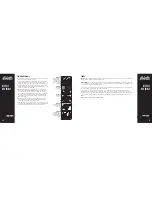
22
23
TOP CAP
PINCH
BOLT(S)
BICYCLE
ASSEMBLY
BICYCLE
ASSEMBLY
HANDLEBAR ASSEMBLY
Remove all protective packaging from the handlebar assembly if not
already done. Turn the fork of the bicycle to face forward. Note that
“forward” means that the wheel mounting slots are in the furthest forward
position. So the wheel axle will be in front of the fork when assembled.
(Fig. A)
Check handlebar stem clamp bolts to be sure they are properly tightened,
and handlebar can not move. The angle of the handlebar can be adjusted.
To adjust; loosen all of the handlebar stem clamping bolts, and rotate the
handlebar to the desired angle. Be sure that the handlebar stays centered
in the stem. Retighten the bolts a LITTLE at
a time being sure that the gap between the stem cap and stem stays even.
Repeat tightening each bolt a little bit until handlebar is secure.
(Fig. B)
Models with gear and/or brake cables:
Locate the handlebar assembly. If your model bicycle comes equipped with
gears and/or handbrakes, you will need to be sure that the brake cables
and shift cables are properly routed. Position the handlebar assembly as if
you were going to install it, and
take a look at the cables. They should run in a smooth arc from the shifter
or brake lever to the front brake or cable stop on the frame. If they are
twisted or kinked, the shifting and braking will not work. Rotate the
handlebars around until the cables are taking the smoothest route.
(Fig. C)
There are 2 basic types of handlebar mounting; Quill and Threadless.
QUILL STEMS
This is a handlebar assembly that has a wedge shaped part at the bottom
of the stem that is inserted into the fork steer tube. Loosen the center
bolt enough so that the wedge and stem can slide into the fork steer tube.
Lower the stem until the mark that says “minimum insertion” is not visible.
Tighten the stem center bolt so that the handlebar assembly is in line with
the fork. If needed, you can re-check this after the front wheel is installed,
and re-adjust.
(Fig. D)
THREADLESS STEMS
This is a handlebar assembly that has a open ended stem with 1 or more
pinch bolts that goes outside of the fork steer tube. For this system it
is important not to disassemble the headset and lose any parts. Be sure
that the end of the fork is on the ground or being held with your free
hand, because once you loosen the top cap, the fork assembly may fall
out of the frame. Loosen the top cap of the fork steer and remove any
cardboard packing, the top cap, and bolt. Set these aside so you can
easily retrieve them. While holding the fork assembly in place, slide the
handlebar assembly onto the fork tube. Replace the top cap and bolt.
Tighten the top cap bolt only until the handlebar assembly and fork
have no free play, but so that the handlebar assembly and fork can still
freely turn left and right. Then tighten the pinch bolt(s) evenly with the
handlebar assembly facing forward. If needed you can re-check this after
the front wheel is installed, and re-adjust.
(Fig. E)
NOTE:
Comfort Series bicycles may be equipped with a stem that has
an adjustable angle. In addition to the normal assembly, these stems will
require angling the stem to the desired position, and securely tightening
the angle bolt located in front of the stem bolt. Failure to do this may
cause loss of steering control.
(Fig. F)
WARNING:
If the stem is not inserted at least to the “Minimum
Insertion” mark, it is possible to over-tighten the stem bolt and
damage the fork steerer tube. If these instructions are not followed,
it could cause an unsafe condition and risk injury to the rider. Check
steering tightness prior to riding by straddling the front wheel. Try
turning the handlebar. If you can turn it without turning the front
wheel, the stem is too loose. Re-align the handlebar with the front
wheel and re-tighten the stem bolt.
INCORRECT
CORRECT
FIG. C
FIG. D
FIG. E
FIG. F
FIG. A
FIG. B














































